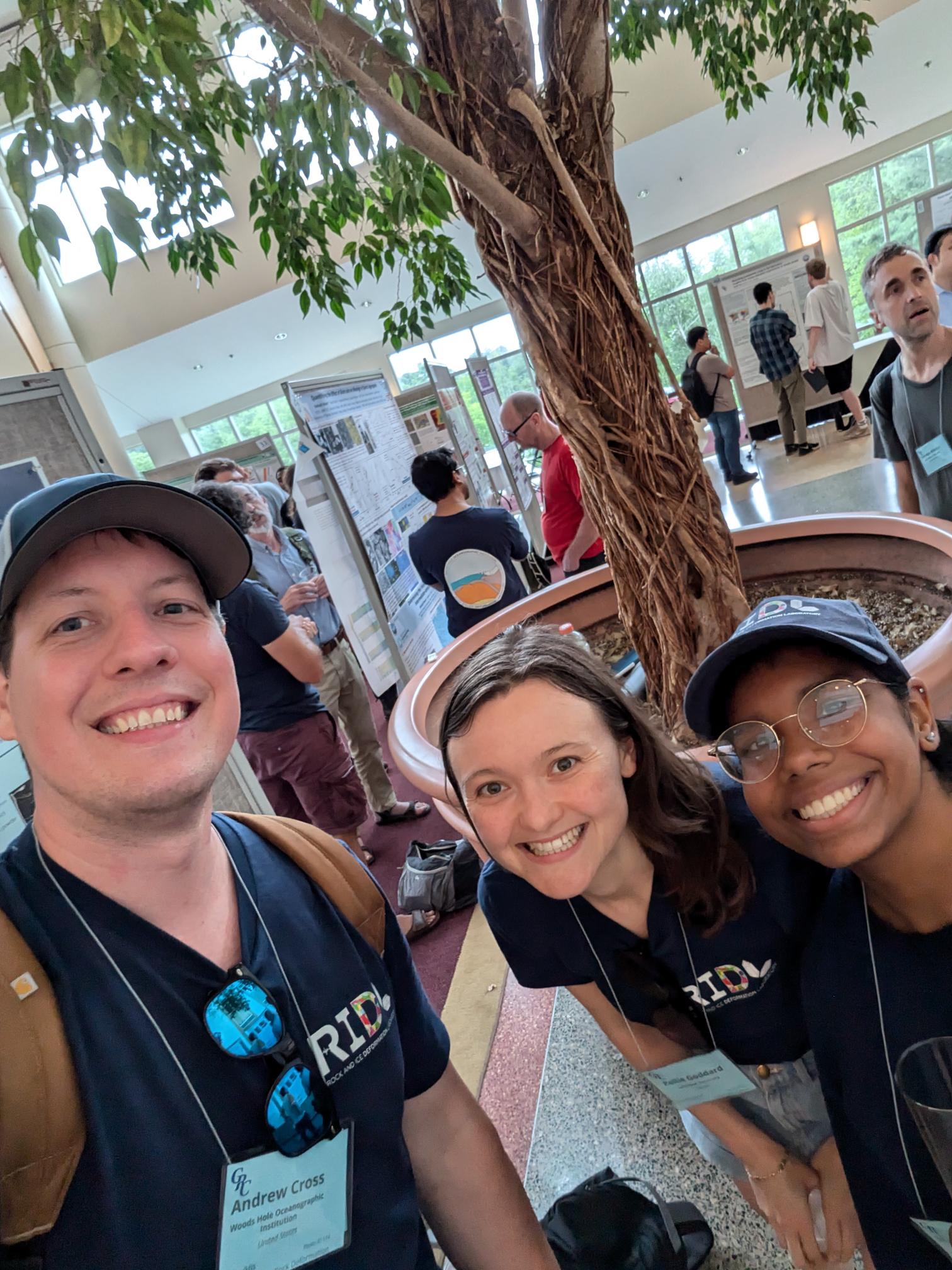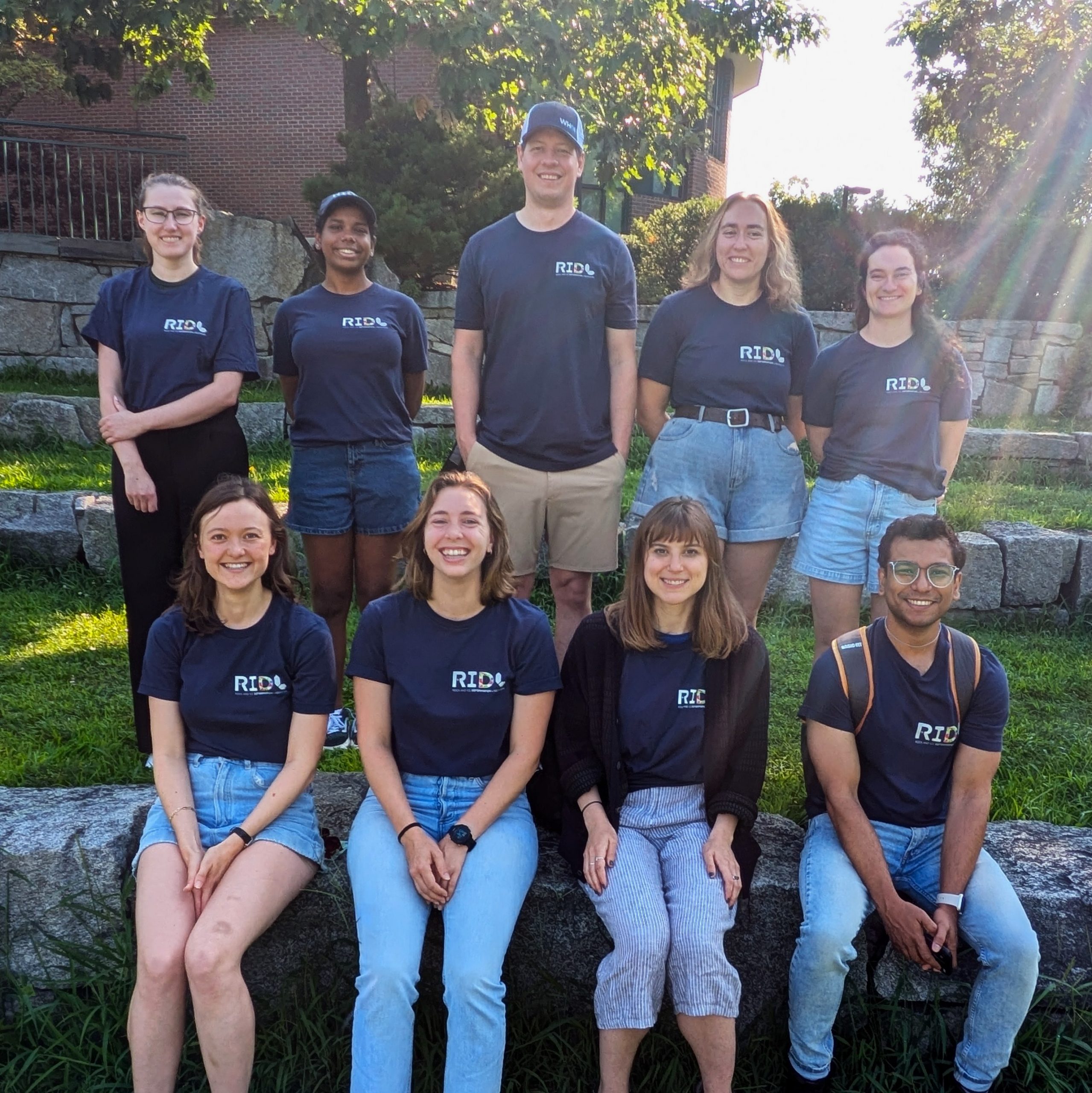Latest News From RIDL
January 2025: Welcome to Dr. Cassandra Seltzer, who joins us as a National Science Foundation (NSF) Postdoctoral Scholar! Cassandra will be splitting her time between WHOI and the Rock and Ice Mechanics Laboratory at LDEO, performing experiments to characterize the geophysical properties of ice containing interstitial water. You can read more about the project here.
2024 updates
December 2024: It was a strong showing for RIDL at the American Geophysical Union (AGU) Fall Meeting in Washington, DC. Halley and Subhajit had posters on display, while Rilee, Caroline, and Andy gave talks, covering everything from ice shelves to the mantle transition zone.
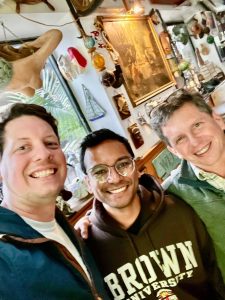
November 2024: All too soon, we are saying farewell to Subhajit, who has been snatched up for an Assistant Professor position at the Indian Institute of Science Education and Research (IISER), Thiruvananthapuram. We still have plenty of ongoing collaborations and future projects lined up, so we'll be seeing lots more of him!
September 2024: Congratulations to Rilee on passing her Generals Examination!
September 2024: Welcome to Madi Fleming, who joins us as a Guest Student from the University of Otago! Madi will be spending six weeks at WHOI as part of her Master's degree, performing low-stress experiments to constrain the relationship between stress and grain size in ice.
August 2024: RIDL was out in force at the Gordon Research Conference on Rock Deformation!
June 2024: We're excited to welcome Halley Wilkinson, who is joining us from Smith College for the summer! Halley will be participating in WHOI's Summer Student Fellowship REU program, and will be studying microstructure evolution across the brittle-to-ductile transition in marble.
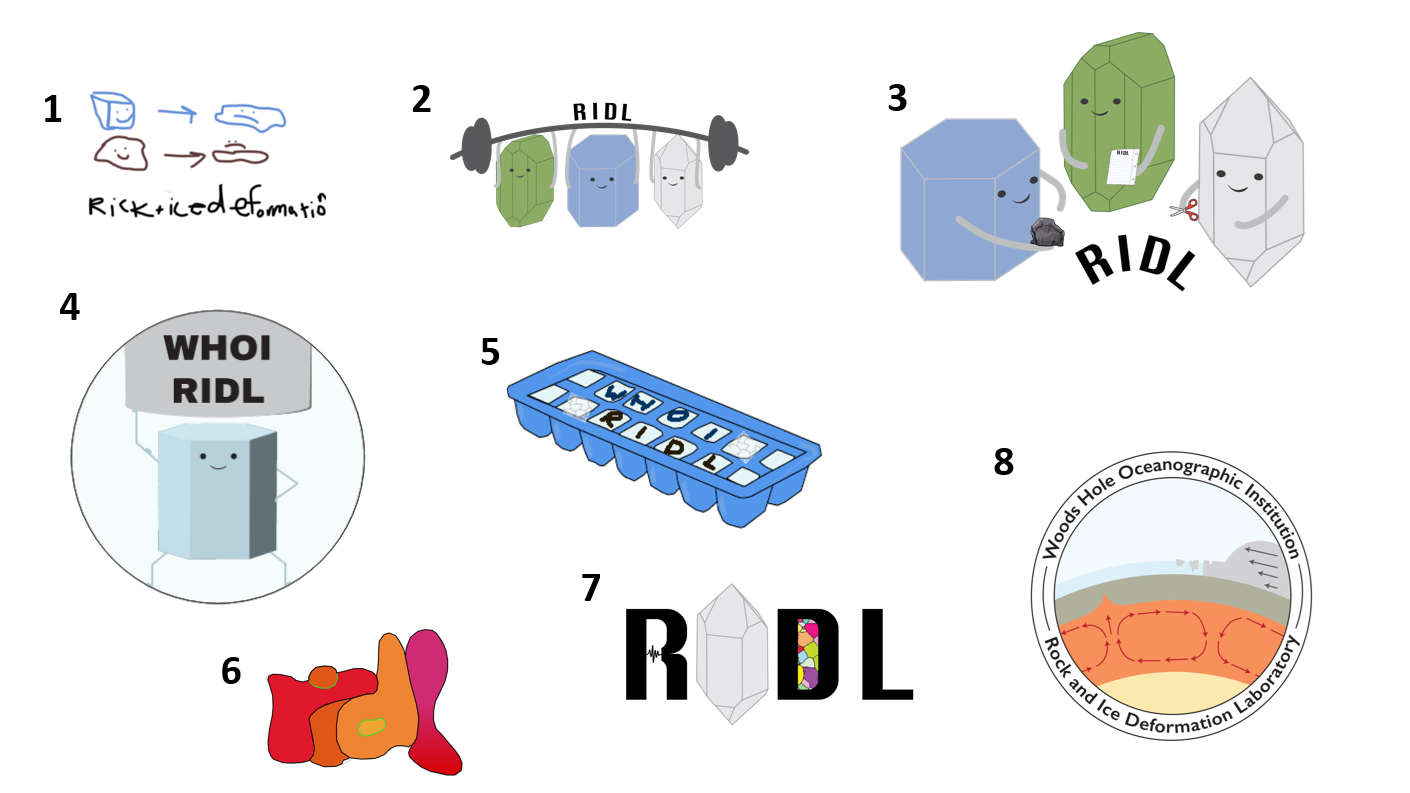
The very worthy candidates for our group logo. After an intense vote, we settled on logos #7 and #8 as our official logo and seal, with #2 as a fun backup.
May 2024: Things got a little heated as we held a competition to determine our group logo. There were many amazing entries, but only one (or two) could emerge victorious.
April 2024: Congratulations to Maia on completing her Thesis Proposal Presentation!
March 2024: Welcome to Caroline Needell, who is joining our group! Caroline is in her first year of the MIT-WHOI Joint Program, working primarily with Catherine Walker in AOP&E. She will be studying ice fabric evolution during plane-strain compression for her second generals project.
February 2024: Maia performed the first tests of her acoustic monitoring system for ice experiments, which were successful! Lots more to come...
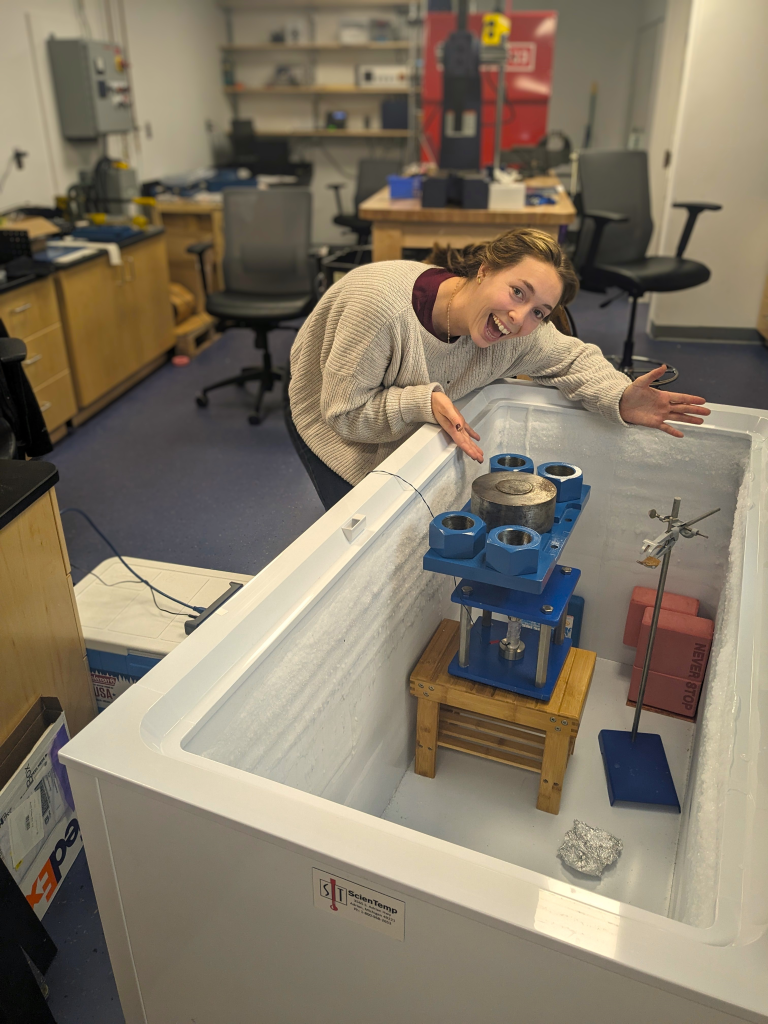
A makeshift dead-weight creep experiment on ice. A miniature broadband acoustic sensor is frozen directly onto the sample to monitor deformation processes happening inside the sample during compression.
January 2024: Rilee is visiting the University of Otago (New Zealand) to collect cryo-EBSD data on ice samples squished under low-stress conditions in our lab.
January 2024: Welcome to Dr. Subhajit Ghosh, who is joining RIDL as a Postdoctoral Investigator! Subhajit is an expert in crustal rheology, and will be conducting high-pressure experiments and EBSD analyses to constrain the strength of the oceanic lower crust.
2023 updates
September 2023: Congratulations to Maia Cohen on passing her Generals Examination!
July 2023: Our project "Microstructural evolution during superplastic ice creep" was just awarded funding by the National Science Foundation!
June 2023: Welcome back to Namitha Kumar, our 2022 Summer Student Fellow superstar, who is entering the MIT-WHOI Joint Program! Namitha will mostly be working with Drs. Vero Le Roux and Pete Barry to study the geochemistry of the oceanic lithosphere.
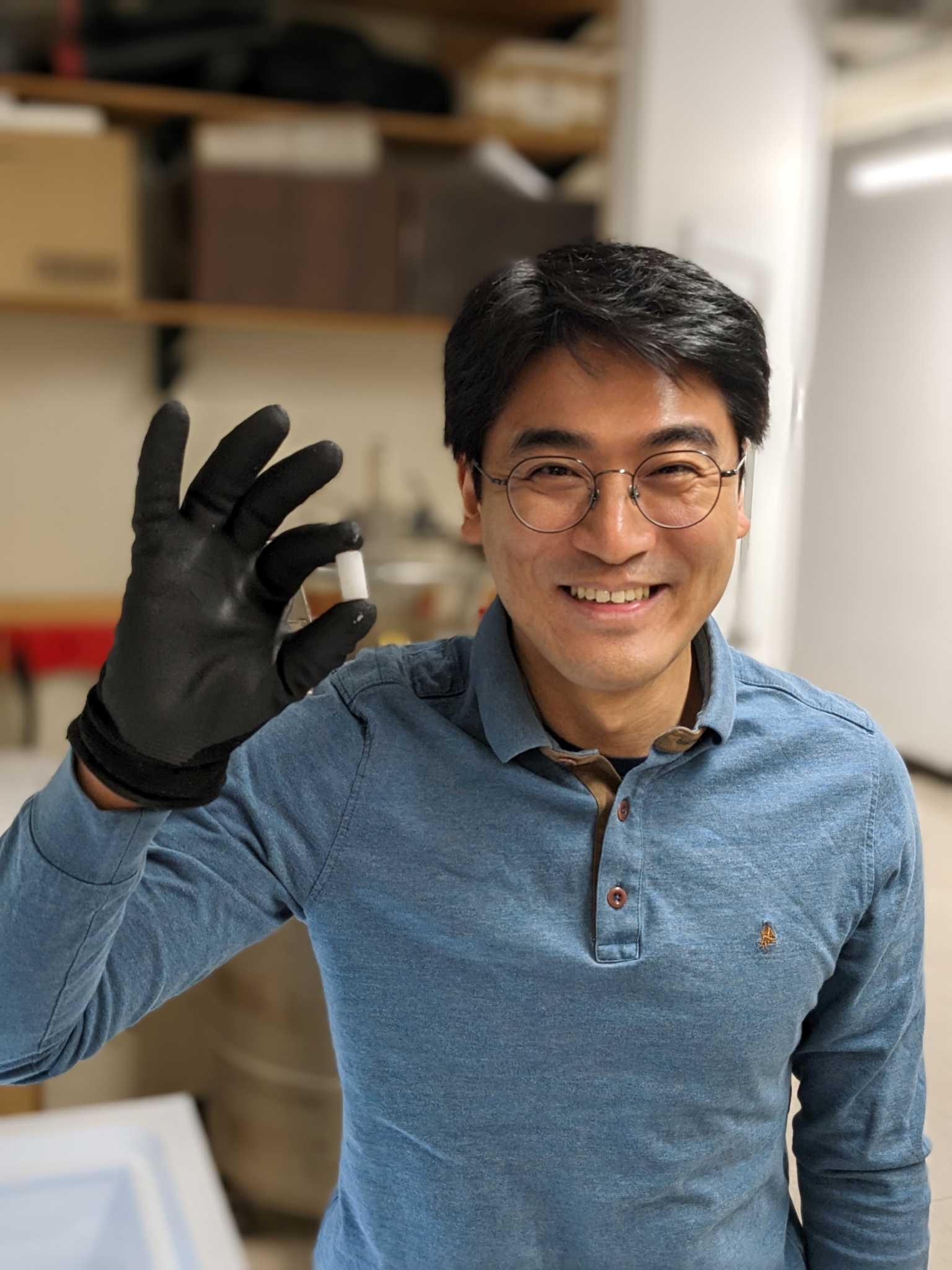
Dr. Daeyeong Kim (KOPRI, Visiting Investigator at WHOI) holding our first successfully deformed ice sample
May 2023: A big moment for the RIDL group as we celebrate our first successful ice experiment!
April 2023: We're excited to welcome back Drs. Daeyeong Kim and Dohyun Kim from the Korea Polar Research Institute (KOPRI). Daeyeong and Dohyun are visiting WHOI for a couple of months to investigate the flow properties of impure ice, following up on a short visit last year.
January 2023: Welcome to Maia Cohen, who is joining our group as part of the MIT-WHOI Joint Program! Maia brings to RIDL her expertise in listening to rocks crack and flow under pressure using acoustic methods.
2022 updates
December 2022: Rellie and Namitha are representing RIDL at the 2022 AGU Fall Meeting in Chicago. Rellie has an invited talk (MR13A-01 - "Transient Weakening and Microstructures Associated with the Quartz-Coesite Phase Transition") and Namitha will be presenting the results of her summer research project (OS55C-0532 - "Determining the Strength of the Oceanic Lower Crust: a Geochemical, Microstructural, and Rheological Investigation of ODP Hole 735B, Southwest Indian Ridge"). Go say hi!
November 2022: We enjoyed hosting Drs. Daeyeong Kim and Dohyun Kim from the Korea Polar Research Institute (KOPRI). Daeyeong and Dohyun are interested in the effect of microplastics on ice flow, and will be back in 2023 to conduct lab experiments at WHOI.
November 2022: Some great news that our proposal titled "Strength of the oceanic crust: new experimental and microstructural constraints" has been recommended for funding!
October 2022: Andy and Rellie traveled to the Advanced Photon Source synchrotron (Argonne National Laborary, Chicago, IL) to conduct high-pressure experiments exploring the quartz-coesite phase transformation. We were joined by MIT-WHOI Joint Program student Maia Cohen, who was shadowing us as part of the In-situ Studies of Rock Deformation (ISRD) research coordination network.
September 2022: Andy and Rellie spent a week collaborating with Dr. David Wallis at the University of Cambridge, UK, using HR-EBSD to investigate dislocation substructures in rocks undergoing phase transformations.
August 2022: The RIDL group was out in force at the Gordon Research Conference on Rock Deformation (Lewiston, Maine). Andy and Rilee presented posters, while Rellie gave an invited talk on her quartz-coesite phase transformation work.
June 2022: Andy, Rellie, Rilee, and Namitha all participated in the Electron Backscatter Diffraction (EBSD) 2022 virtual conference. Rellie took home the prize for Best Talk by an Early Career Research for her presentation titled "Microstructural Signatures of the Coesite-Quartz Transformation: New Insights from High-Pressure Experiments and EBSD Analysis". Woohoo!
May 2022: We are thrilled to welcome two new members of the Rock and Ice Deformation Laboratory!
- Rilee Thomas is joining the MIT-WHOI Joint Program fresh out of a Masters program at the University of Otago (New Zealand). Rilee is an expert on all things icy, and will be studying grain-scale creep processes in ice for her graduate research.
- Namitha Kumar has joined us from the University of Michigan as a WHOI Summer Student Fellow. Namitha will spend the summer investigating the thermal and rheological structure of oceanic detachment faults.
Welcome, Rilee and Namitha!
2021 updates
December 2021: RIDL was out in force at the AGU 2021 Fall Meeting! Rellie convened a session on using microscale observations to understand tectonic processes. Meanwhile, Andy presented a poster about phase-transformation induced weakening, and an invited talk about phase mixing and strain localization.
October 2021: Rellie and Andy travelled to the Advanced Photon Source (APS) synchrotron at Argonne National Laboratory, to conduct high-temperature, high-pressure experiments looking at mineral weakening during phase transformations. It was our first time back at APS since the facility closed its doors to external users in March 2020!
October 2021: Andy gave an invited talk entitled "Tracking Dynamic Recrystallization Across a Broad Range of Homologous Temperatures and Stresses" at the Geological Society of America annual meeting, GSA 2021, summarizing the results of a few recent papers on dynamic recrystallization accompanying the high-temperature deformation of quartz and ice (Cross et al., 2017; Cross & Skemer, 2019; Fan et al., 2021).
September 2021: We are thrilled to welcome Dr. Rellie Goddard to our group as a Postdoctoral Investigator! Rellie arrives at WHOI fresh from her doctoral studies at the University of Oxford, where she developed new subgrain piezometers for calculating stresses in exhumed polymineralic rocks. While at WHOI, Rellie will be researching the interplay between deformation and metamorphic phase transformations in quartz and olivine.
May 2021: Dr. Matej Pec joined us for a week to collect EBSD data on fault rock (semi-brittle) samples produced in his lab at MIT. Hopefully this will be the first of many collaborations between the MIT and WHOI rock deformation laboratories!
May 2021: Andy had a great time chatting with second grade students from Ridge Central Elementary School, Chicago. The students had questions about everything from earthquakes and volcanoes, to glaciers on Mars, to fossils (and much more!).
2020 updates
December 2020: The lab is starting to come together. Our ice squeezer and EBSD system were both installed at the start of the month. Christmas come early!
November 2020: The Griggs rig has arrived in the lab. It was kindly donated to us by Pam Burnley (UNLV), who found it in the late Harry Green's lab at UC Davis. Several key components are missing (including the load cell, gear train and housing, pressure valves, and pistons), but with a little TLC we'll have it up and running, and ready to squeeze rocks under high temperatures and pressures.
October 2020: Andy gave an invited talk ("The origin and importance of ultramylonites: an experimental perspective") at the Geological Society of America (GSA) annual meeting, about the microscopic processes that lead to plate boundary formation. There was a lot of great science on display, particularly by early career researchers.
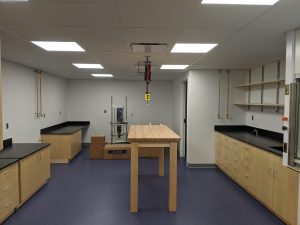
October 2020: The lab renovation is complete! This is probably the cleanest it'll ever look. Stay tuned for updates.
June 2020: A big month for the Rock and Ice Deformation Laboratory. Our first two National Science Foundation (NSF) proposals have been recommended for funding:
- EAR-2023128 ("Collaborative Research: Transformation Plasticity as a Transient Creep Mechanism in Earth’s Crust and Mantle"). This project involves some very cool experiments in a multi-anvil D-DIA press on a synchrotron beamline, looking at mineral weakening during metamorphic phase transformations in quartz and olivine. "Transformation plasticity" is thought to weaken subducting slabs as they pass through the mantle transition zone, and might provide a source for earthquakes in the upper mantle. This project is a collaboration between WHOI, the University of Pennsylvania (PI: David Goldsby), and the University of Minnesota (PI: Lars Hansen).
- EAR-2003389 ("Upgrade of an Electron Backscatter Diffraction (EBSD) System to Establish a Center for State-of-the-Art Microstructural Analyses"). These funds will pay for a state-of-the-art EBSD system, to be installed just down the road at the Marine Biological Laboratory. A new Oxford Instruments Symmetry detector will replace an old EBSD camera installed in the early 2000's. EBSD technology has come a long long way since then, and the new system will enable new frontiers in our understanding of the crystalline structure and strength of rocks, ice, and biominerals (shells, corals, forams).

Our experimental lab....coming soon
May 2020: The Rock and Ice Deformation Laboratory (RIDL) at Woods Hole Oceanographic Institution is now live.....or, at least, our webpage is! We study the ways in which rocks and minerals deform on the atom- to grain-scale, and how those microscopic processes influence geodynamic phenomena like plate tectonics, subduction, mountain building, and glacial flow. Much of our research combines laboratory experiments with microstructural analyses; that is, we squeeze rocks and study how they deformed.

